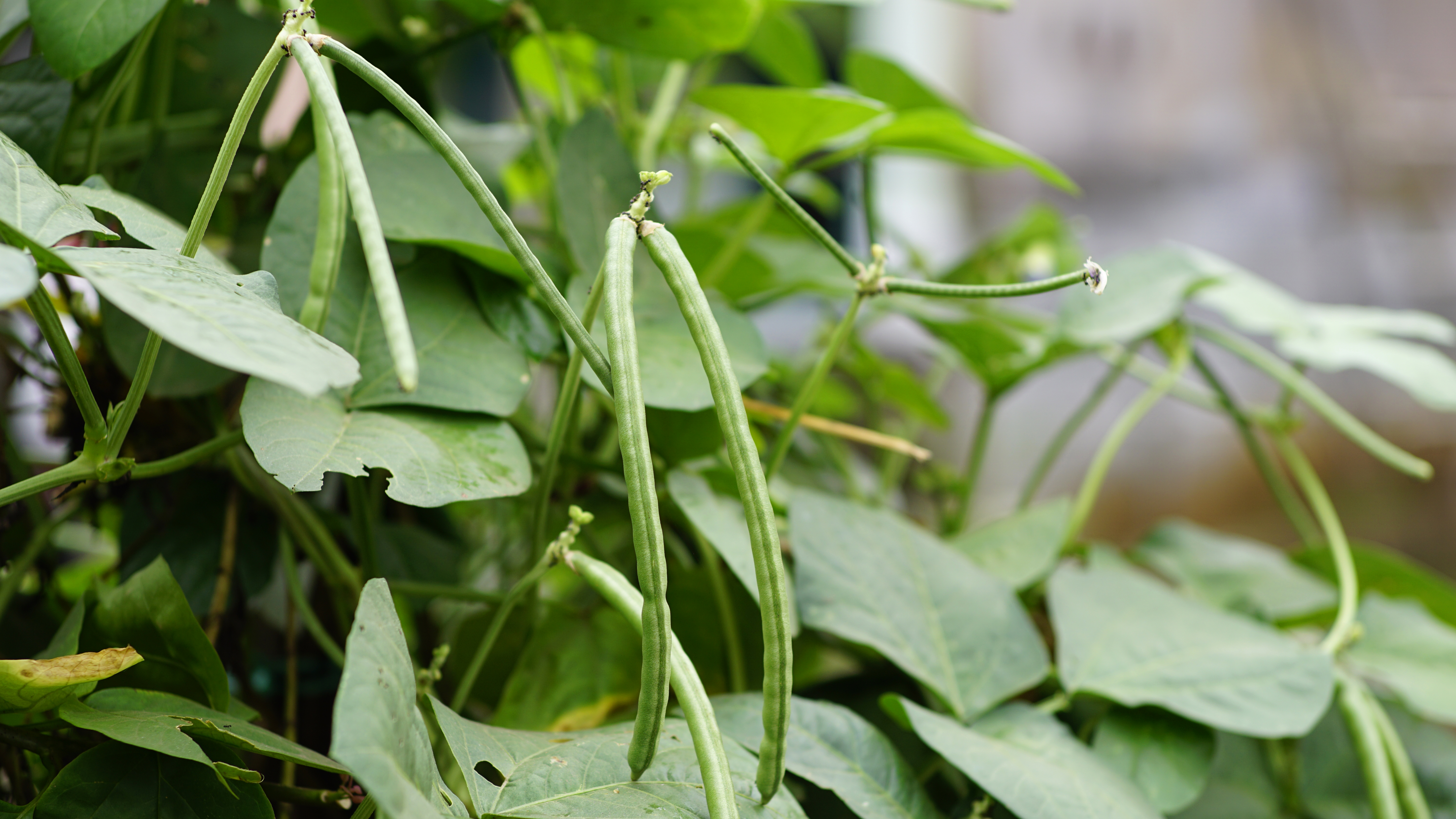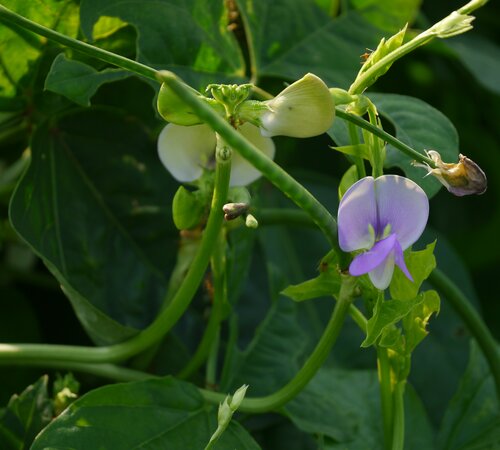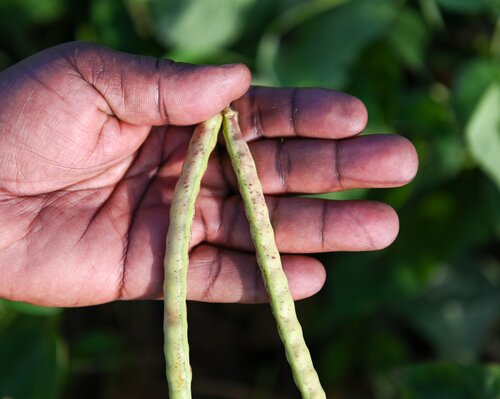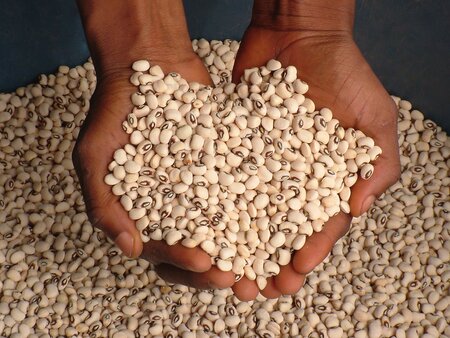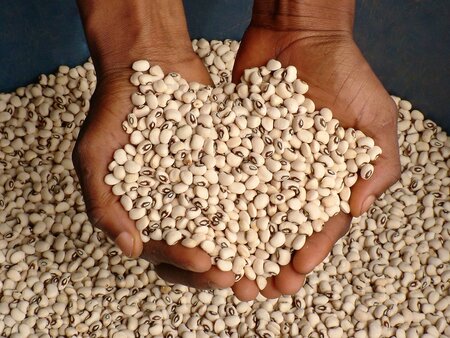Cowpea
Vigna unguiculata
Crop Overview
Cowpea (Vigna unguiculata (L.) Walp.) is an annual, drought-tolerant legume that is a key source of food for millions of people, particularly in sub-Saharan Africa and Southeast Asia. Cowpea was domesticated some 2,500 years ago, possibly in southern Africa, before spreading to East and West Africa. It has since spread to other parts of the world, including Asia, Latin America and the southern United States. Cowpea thrives in challenging conditions, particularly in drought-prone regions. Common names include black-eyed pea and southern pea in the USA, and niébé in West Africa.
Characteristics, Cultivation and Agricultural Practices
Cowpea grows as a bush or as a climbing or trailing vine, depending on the variety. It tolerates a wide range of soil types, including sandy and low-fertility soils. It grows best in warm climates, with an optimal rainfall range of 400–700 mm, and tolerates temperatures up to 35°C, making it well-suited to arid regions where other crops may struggle. Cowpea is a fast-growing crop, with some varieties maturing in as little as 60 to 90 days, allowing for multiple harvests or use as an emergency crop during short rainy seasons.
Cowpea is grown in mixed cropping systems, often with maize, millet or sorghum, as it enhances soil fertility by fixing nitrogen. Traditional farming practices with minimal fertilizer and pesticide use are common in many regions, especially in smallholder systems in sub-Saharan Africa. Estimated grain yields in 2022 range from 150 kg per hectare in Guinea-Bissau to over 5.5 tonnes per hectare in Iraq (FAOSTAT).
Nutritional, Economic and Medicinal Value
In Africa, people eat the young leaves as a leafy vegetable and the immature pods, immature seeds and the mature dried seeds of cowpea in various traditional dishes, including stews, soups and porridges. Cowpea is highly nutritious, providing a rich source of protein, dietary fiber and essential minerals such as iron, potassium and magnesium. The crop is also an excellent source of folate and vitamin B6. It offers a plant-based protein option that is especially valuable in regions where animal protein is scarce or unaffordable. Cowpea’s low glycemic index makes it ideal for diabetic diets, and its high antioxidant content supports cardiovascular health.
The crop was grown on about 15 million hectares worldwide in 2022, more than 90% in Africa (FAOSTAT), yielding a total of some 9.8 million tonnes of grain. The largest producers are Niger, with nearly 6 million hectares, and Nigeria, with some 4.8 million hectares.
The stems, pods and leaves are also widely used as livestock feed, particularly during dry seasons when other sources of feed are scarce.
Spreading varieties are often planted as cover crops or as green manure to prevent soil erosion and reduce weed infestation.
Cowpea is used in traditional medicine to treat digestive ailments and malnutrition.
Cultural Importance
Cowpea holds cultural significance in various regions, especially in Africa, where it is often used in rituals and festivities. The crop may be included in cultural ceremonies, such as harvest festivals and rites of passage, and holds symbolic value as a source of resilience and sustenance. In some African communities, cowpea is used in offerings to ancestors or deities, underscoring its role as both a food and a cultural symbol of heritage and endurance.
Gender Perspectives
Most cowpea in sub-Saharan Africa is grown by women in smallholder subsistence farming systems. Women are also often responsible for processing and selling cowpeas in local markets. Cowpea thus contributes significantly to women's livelihoods, household food security and nutrition.
Why is the Crop Underutilized?
Challenges in cowpea production include low yields in traditional farming systems, pest and disease susceptibility and limited access to improved seeds. Research and development efforts are underway to address these issues, focusing on increasing awareness, enhancing market linkages and introducing improved farming techniques. Promoting the crop’s nutritional and environmental benefits could increase its demand and expand cultivation.
Diversity Available in Genesys
As of December 2024, Genesys, the online information platform about plant genetic resources for food and agriculture conserved in genebanks worldwide, lists more than 49,000 seed samples of cowpea. More than 25,000 of these are landraces. The largest holdings are in the genebanks of:
- The International Institute of Tropical Agriculture - 17,165 samples.
- The Plant Genetic Resources Conservation Unit, Southern Regional Plant Introduction Station, University of Georgia, USDA-ARS, USA - 8,315.
- Embrapa Recursos Genéticos e Biotecnologia in Brazil - 4,928 samples.
- Embrapa Meio Norte in Brazil - 3,785 samples.
Current Breeding Efforts
Recent breeding efforts are focusing on improving cowpea’s resistance to pests and diseases, enhancing drought tolerance and increasing yields and developing and evaluating dual-purpose varieties that increase both food and fodder quantity.
Notable cowpea breeding programs include those at IITA in Nigeria, the Feed the Future Innovation Lab for Legume Systems Research at Michigan State University, USA, the Council for Scientific and Industrial Research – Savannah Agricultural Research Institute (CSIR-SARI) in Ghana, the Institut de l'Environnement et de Recherches Agricoles (INERA) in Burkina Faso and the National Agricultural Research Organisation (NARO) in Uganda.

